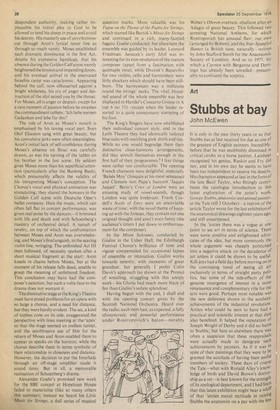Art
Stubbs at bay
John McEwen
It is only in the past thirty years or so that Stubbs has at last received his due as one of the greatest of English painters. Incredibly, before that he was snobbishly dismissed in critical circles as a horse painter. Landseer recognised his genius, Ruskin and Fry did not; and in his own day he seems to have been too independent to receive his deserts. His champion appeared at last in the form of the late Basil Taylor, who fittingly contributes the catalogue introduction to this latest exploration of the artist's work, George Stubbs, anatomist and animal painter. at the Tate (till 3 October)—a reprint of the article Taylor wrote for the last exhibition of the anatomical drawings eighteen years ago. and still unsurpassed.
In the 'sixties there was a vogue at one point to see art in terms of science. There were some positive and enlightened advocates of the idea, but more commonly the whole argument was cheaply politicised into a negative attack on the decadence of art unless it could be shown to be useful. Kill-joys had a field day before moving 0t0 the continuing trend of seeing all art exclusively in terms of straight party politics, but some of the side-effects of the genuine resurgence of interest in a more renaissance and complementary role for the arts were good. Perhaps most notable was the new deference shown to the aesthetic achievements of the industrial revolution, Artists who could be seen to have had a practical and scientific interest at that date also benefited. It helped the reputation of Joseph Wright of Derby and it did no harm to Stubbs; but here as elsewhere there was often a suspicion that these reappraisals were actually made to denigrate such achievements by painters. As if it was la spite of their paintings that they were to be granted the accolade of having been useful members of society. These days of course the Tate—what with Ronald Alley's knowledge of birds and David Brown's doctorship as a vet—is best known for the strength of its zoological department, and I had fear that this latest exhibition might bear a whiff of that 'sixties moral rectitude in raising, Stubbs the anatomist on a par with the less
socially acceptable Stubbs the painter. The selection for the show does not altogether dispel these doubts and seems therefore at variance with the catalogue, in which of course Basil Taylor has no doubts at all.
As he and Judy Egerton of the Tate make clear, Stubbs's anatomical research was always' at the service of his art. The Anatomy of the Horse, for instance, although brilliantly drawn and observed and therefore of some orthopaedic use, was of limited value to veterinary science because it showed no details of the blood supply and major viscera. A Comparative Anatomical Exposition was similarly limited, and it is significant that Stubbs, quite a conscientious committeeman, played no part in the foundation of the Royal Veterinary College, though he was by then an Academician and well into distinguished old age. His study of anatomy, like his study of perspective, was as an artist perfecting his craft in the manner of the old masters. And prodigious worker that he was, he succeeded triumphantly.
It is now almost twenty years since the last (and first since 1885 in London) major Stubbs retrospective was assembled by Bryan Robertson at the Whitechapel, and it does seem a disgrace even in these hard times that neither the Tate nor the Royal Academy ace prepared to mount the great formal exhibition he deserves. Surely the Louvre and/or the Metropolitan would take It and share the costs. In the meantime we must make do with another rather halfhearted little affair: excellent in that it Shows some of the drawings for the ComParative Exposition from Worcester, Mass., and gathers together a few uncharacteristic Paintings of peculiar animals from the Royal College of Surgeons and elsewhere, but inadequate in the irresolution of its purpose and the scale of its coverage even of the anatomical studies.
In the manner of multi-cinemas--a tendency to be stopped at any cost—two other exhibitions have to be passed through on the way to the Stubbs. They are both extremely academic: much early, preparatory or trivial work being shown simply because it has been done by the famous artists Gonzalez and Malevich—in the case of Malevich, an academicism wonderfully served by Andrei B. Nakov 'Whom God Preserve' of Paris's twenty-eight times footnoted catalogue introduction. That unfortunately is not all. For years now the Tate has lamented the Collection's deficiency in lwentieth-century Russian abstract art, Particularly its lack of a Malevich. This summer Annely Juda's patiently gathered Selection of Russian pioneer art (reviewed 19 June) gave the Tate the opportunity to buY a fine painting by the artist and much else besides, which had it been taken would have at least partially filled this embarrassing gap. Needless to say it was not taken-even the rare chance to buy a Malevich being rejected out of hand. Now, to cap it all, the Gallery has the effrontery to mount the Present laughably specialised smattering of Malevich's jots and doodles.



































 Previous page
Previous page